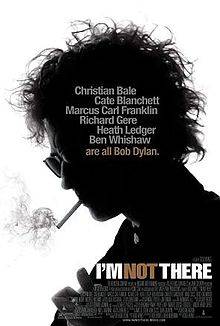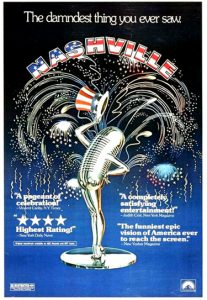I’m Not There (2007)
The Many Lives of Bob Dylan
Summary: I’m Not There will be fun for Dylanologists, but others may find its riffs on Dylan lore slow going.
Viewers of I’m Not There fall into two rough categories: Dylanologists and everyone else. For Dylanologists (meaning serious students of Dylan’s career) the movie will seem like an elaborate in-joke, riffing on the key events of his career (“going electric” at the 1965 Newport Folk Festival, the 1966 motorcycle crash, his temporary conversion to born-again Christianity, etc.). Casual Dylan fans may be confused by the movie, unable to separate fact from fiction, especially given its non-linear narrative structure. I’m Not There is very unlikely to “convert” anyone into a Bob Dylan fan; the movie does not teach viewers much about Dylan’s career, because it simply assumes you are well-versed in it.
Director Todd Haynes is clearly aiming for the Dylanologists in the audience. The movie is a bold concept; Dylan has managed to reinvent himself, or at least his public persona, so many times during his fifty year career that presenting these distinct phases as if they were six different characters seems almost natural. How was it possible for one man to change so often? Yet Dylan is infamous for his evasiveness, and so we don’t really know much about Dylan the man. I’m Not There is an appropriate title.
Presenting six different characters to represent phases in Dylan’s career might have been easier on the audience had they been presented in chronological order, rather than as frequent and inexplicable transitions between the six characters.
The Woody Guthrie character (Marcus Carl Franklin), is depicted as an 11 year old African-American boy (but with his references to drinking wine, and his years on the road, maybe he is really an 11 year old actor playing an older character?). The real Guthrie was an American folk singer, most famous for writing “This Land Is Your Land,” and was a major influence on Dylan. The very early Dylan of 1961-62 was even consciously imitating the dying Guthrie’s singing voice (giving Dylan his early and lasting reputation for substandard singing). The Guthrie sequences in I’m Not There are effective at portraying the hobo life that Guthrie lived (and that Dylan perhaps idealized), but are some of the least “accurate” scenes from a biographical perspective.
The Jack Rollins character (Christian Bale) is a successful young folk singer during the years 1963-64 (The Times They Are A-Changin’ years). These were the years when Dylan achieved his initial success, and enjoyed widespread credibility as “the voice” of the 1960s civil rights movement, a role he later disavowed. Folk music devotees of the time saw Dylan almost as a savior, especially when teamed up with the “queen” of folk, Joan Baez (well played here by Julianne Moore). Bale’s performance captures the “Aw, shucks” persona of this early Dylan, a “toad” who was inexplicably the best song-writer of his generation. The Rollins character is also shown later becoming a born-again Christian, as Dylan did in the late 1970’s, alienating many of his fans.
The Arthur Rimbaud character (Ben Whishaw) is a poet who is being interviewed in an isolated room, and gives rather bleak (if poetic) answers to the questions posed. Dylan claims to have been influenced by Rimbaud’s poetry, and so the Rimbaud character is meant to symbolize Dylan the poet, but is not associated with a particular period of his career. The Rimbaud sequences are very short transitional sequences with no connective storyline.
Cate Blanchett’s depiction of Jude Quinn is the highlight of the movie. Blanchett here bears an uncanny resemblance to the Dylan of 1965-66, the peak of his fame and the height of his career. Blanchett conveys Dylan’s tics and anger, and you can feel the pressure that Dylan must have felt living at the center such a maelstrom as his 1965-66 world tour (where he was routinely booed for playing electric guitar). Casting a woman for this role really works in conveying the weird, slightly androgynous quality of Dylan in these years. Dylan’s early folk fans felt betrayed, not only for his going electric (here the infamous 1965 Newport Folk Festival, when Dylan “went electric,” is shown as the band firing machine guns at the audience), but also for his wacky Carnaby Street wardrobe and complete indifference to the protest movement. Many of the Jude Quinn sequences were shot in black-and-white, a conscious allusion to D.A. Pennemaker’s ground-breaking documentary film about Dylan, Don’t Look Back (1965). There’s also a nice scene showing Quinn cavorting with The Beatles in a fast motion visual style reminiscent of A Hard Day’s Night (1964). Frankly, a whole movie of Cate Blanchett as the 1965-66 Dylan probably would have been more enjoyable than I’m Not There (just as Don’t Look Back is).
The Robbie Clark character (Heath Ledger) is a movie actor who stars in a biopic about the Jack Rollins character (the early Dylan), bringing us into a movie-within-a-movie situation (if things weren’t confusing enough already). The Robbie Clark character serves to dramatize his relationship with his wife, Sarah, from whom he divorced after a bitter custody fight for their children. This is our most intimate glimpse of Dylan as a husband and father. Dylan’s painful break from Sarah somehow inspired the songs from Blood on the Tracks (1975), which many critics feel is the only Dylan album that matched the quality of his best early albums such as Highway 61 Revisited (1965) and Blonde on Blonde (1966).
The Billy the Kid (Richard Gere) sequences seem out-of-place. Yes, Dylan once played in a movie about Billy the Kid (though not as Billy), and Dylan’s persona has a certain outlaw quality. But this Billy the Kid (coming out of seclusion to help a small town fight back against a land-expropriating railroad company?) bears so little resemblance to Dylan’s career, that I could have skipped this whole character.
It’s difficult to evaluate such an unusual movie. The music is fantastic (if you like Dylan’s music). The performances are all solid, with Blanchett as the stand-out star. And yet if you are not familiar with Dylan’s career, what exactly are you watching? Some viewers may appreciate the original visual style(s) of the movie (and the music) and not be bothered that they are unable to distinguish the facts from the fiction. Others will scratch their head and ask what it was all about, assuming they can sit through it for the full two hours and fifteen minutes.






Be First to Comment